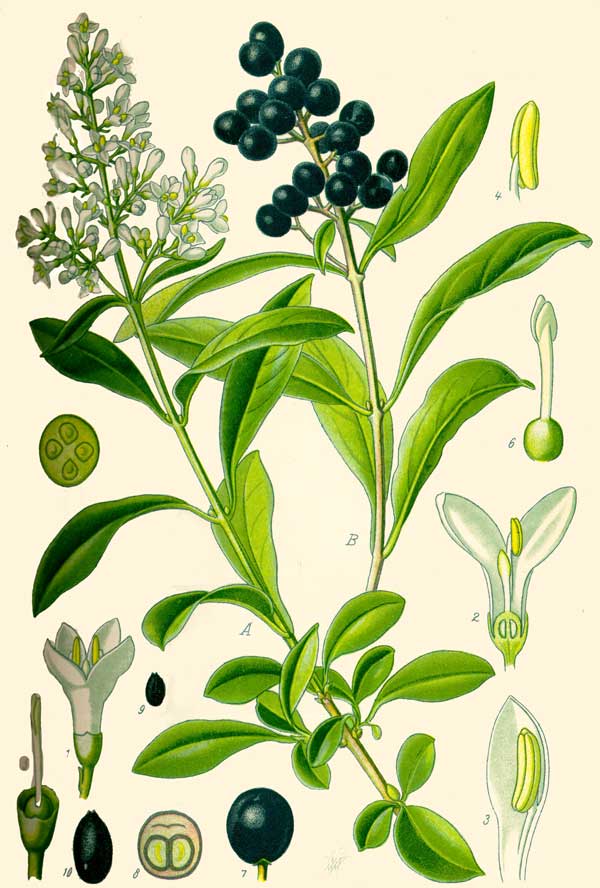
Ligustrum vulgare
Classification System: APG IV
Superregnum: Eukaryota
Regnum: Plantae
Cladus: Angiosperms
Cladus: Eudicots
Cladus: Core eudicots
Cladus: Asterids
Cladus: Lamiids
Ordo: Lamiales
Familia: Oleaceae
Tribus: Oleeae
Subtribus: Ligustrinae
Genus: Ligustrum
Sectio: L. sect. Ligustrum
Series: L. ser. Ligustrum
Species: Ligustrum vulgare
Varietates: L. v. var. italicum – L. v. var. vulgare
Name
Ligustrum vulgare L., Sp. pl. 1:7. 1753
Synonyms
Homotypic
Olea humilis Salisb., Prodr.: 13. 1796, nom. illeg.
References
Linnaeus, C. 1753. Species Plantarum 1: 7.
Links
USDA, ARS, Germplasm Resources Information Network. Ligustrum vulgare in the Germplasm Resources Information Network (GRIN), U.S. Department of Agriculture Agricultural Research Service.
Vernacular names
العربية: تمرحنة شائعة
català: Olivereta
čeština: Ptačí zob obecný
Cymraeg: Yswydden
dansk: Almindelig Liguster
Deutsch: Gewöhnlicher Liguster
English: Wild Privet
español: Aligustre
euskara: arbustu
suomi: Aitalikusteri
français: Troène commun
galego: Alfaneiro
magyar: Közönséges fagyal
հայերեն: սրնգենի սովորական
italiano: Ligustro comun
norsk bokmål: Liguster
Nederlands: Wilde liguster
norsk nynorsk: Liguster
polski: Ligustr pospolity
português: Alfeneiro
română: Lemn câinesc
русский: Бирючина обыкновенная
slovenčina: Zob vtáčí
slovenščina: Navadna kalina
svenska: Liguster
Ligustrum vulgare (wild privet, also sometimes known as common privet or European privet) is a species of Ligustrum native to central and southern Europe, north Africa and southwestern Asia, from Ireland and southwestern Sweden south to Morocco, and east to Poland and northwestern Iran.[1][2][3][4][5]
Description
Berries
It is a semi-evergreen or deciduous shrub, growing to 3 m (rarely up to 5 m) tall. The stems are stiff, erect, with grey-brown bark spotted with small brown lenticels. The leaves are borne in decussate opposite pairs, sub-shiny green, narrow oval to lanceolate, 2–6 cm long and 0.5–1.5 cm broad. The flowers are produced in mid-summer in panicles 3–6 cm long, each flower creamy-white, with a tubular base and a four-lobed corolla ('petals') 4–6 mm diameter. The flowers produce a strong, pungent fragrance that many people find unpleasant. The fruit is a small glossy black berry 6–8 mm diameter, containing one to four seeds. The berries are poisonous to humans but readily eaten by thrushes, which disperse the seeds in their droppings.[4][5][6]
Plants from the warmer parts of the range show a stronger tendency to be fully evergreen; these have sometimes been treated as a separate variety Ligustrum vulgare var. italicum (Mill.) Vahl,[5] but others do not regard it as distinct.[1]
Cultivation and uses
In the British Isles it is the only native privet, common in hedgerows and woodlands in southern England and Wales, especially in chalk areas; it is less common in northern England, Scotland, and Northern Ireland, where it only occurs as an escapee from cultivation.[5][7][8]
The species was used for hedging in Elizabethan gardens in England, but was superseded by the more reliably evergreen introduction L. ovalifolium from Japan.[7]
A number of cultivars have been selected, including:[5]
'Aureum' – yellow leaves.
'Buxifolium' – small, oval leaves not over 2.5 cm long.
'Cheyenne' – cold-tolerant clone selected in North America.
'Chlorocarpum' - berries green.
'Insulense' – long, narrow leaves 5–11 cm long and 1-2.5 cm broad.
'Leucocarpum' – berries greenish-white.
'Lodense' – dense, dwarf shrub (the name is a portmanteau of 'low' and 'dense').
'Pyramidale' – fastigiate.
'Xanthocarpum' – berries yellow.
Invasiveness
The species is listed as invasive as an introduced plant in Australia,[9] Canada,[10] New Zealand,[11] and the United States.[12][13] It is also fully naturalised in Mexico's highlands[14] and Argentina.[15]
Etymology
Ligustrum means ‘binder’. It was named by Pliny and Virgil.[16]
References
Flora Europaea: Ligustrum vulgare
Plants for a Future: Ligustrum vulgare
"Ligustrum vulgare". Germplasm Resources Information Network (GRIN). Agricultural Research Service (ARS), United States Department of Agriculture (USDA). Retrieved 17 December 2017.
Blamey, M. & Grey-Wilson, C. (1989). Flora of Britain and Northern Europe. ISBN 0-340-40170-2
Bean, W. J. (1978). Trees and Shrubs Hardy in the British Isles vol. 2: 576–577. ISBN 0-7195-2256-0.
Flora of Northwest Europe: Ligustrum vulgare[permanent dead link]
The Reader's Digest Field Guide to the Trees and Shrubs of Britain p. 52.
Flora of Northern Ireland: Ligustrum vulgare
Potential Environmental Weeds in Australia: [1]
Canadian Botanical Conservation Network: Information on Invasive Shrub and Vine Species Archived 2007-08-27 at the Wayback Machine
Protecting and Restoring our Natural Heritage: Appendix one: Invasive weeds Archived 2015-01-28 at the Wayback Machine
Swearingen, Jil; Reshetiloff, K.; Slattery, B; Zwicker, S. (2010). Plant Invaders of Mid-Atlantic Natural Areas, 4th Edition (PDF). National Park Service and U.S. Fish & Wildlife Service. p. 71.
Invasive species: European privet
Plantas medicinales. Virtudes insospechadas de plantas conocidas. 1987. Reader's Digest México S.A. de C.V. Printed by Gráficas Monte Albán S.A. de C.V. Querétaro, Mexico. ISBN 968-28-0099-4
Gavier-Pizarro, Gregorio I.; Kuemmerle, Tobias; Hoyos, Laura E.; Stewart, Susan I.; Huebner, Cynthia D.; Keuler, Nicholas S.; Radeloff, Volker C. 2012. Monitoring the invasion of an exotic tree (Ligustrum lucidum) from 1983 to 2006 with Landsat TM/ETM+ satellite data and support vector machines in Cordoba, Argentina. Remote Sensing of Environment. 122: 134-145.
Gledhill, David (2008). "The Names of Plants". Cambridge University Press. ISBN 9780521866453 (hardback), ISBN 9780521685535 (paperback). p 237
Retrieved from "http://en.wikipedia.org/"
All text is available under the terms of the GNU Free Documentation License

